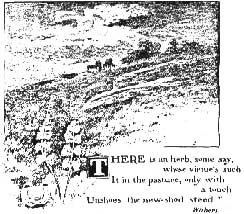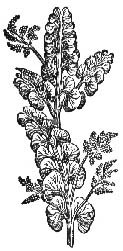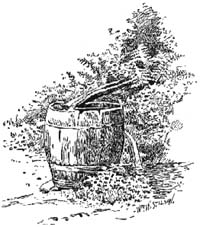|
|
|
|
. |
It was an unusually mild winter when we first discovered the grape ferns. All I knew about them then was that there were at least two species in southern Illinois and one was on Illinois' Threatened and Endangered Species list. My Peterson's Field Guide to the Ferns included an illustration of Moonwort, Botrychium lunaria, that looked just like the tiny green sprig growing in our maple woods. It looked like a Moonwort, but Moonwort looks nothing like the ferns of Grandmother's parlor. I was curious enough to investigate the history of this primitive plant. An ancient volume titled Our Ferns in Their Haunts, by Willard N. Clute states: In the Old World, this plant was once held in great repute for its supposed power of working all sorts of wonders. Its old names of "blasting-root" and "spring-wurzel" were given it under the impression that the strongest locks would give way if it were merely brought in contact with them. Pliny, the Roman recorder of natural history (and related topics) of A.D. 23-79 (he died during the destruction of Pompeii where he had gone to investigate the eruption of Mt. Vesuvius), preserved one story of the Moonwort. According to him, if anyone touched a lock with it, the lock would open. Unfortunately, a woodpecker was required to lead one to this magical plant. Here is the method of recovery. First, find a woodpecker nest. After the bird leaves the nest hole, stop up the entrance with wood. The woodpecker, anxious to feed the young in the nest, will find the Moonwort, touch the blocked entrance with the root, and the entrance will be opened. Meanwhile, you must either light a fire near the nest tree or, perhaps, just lay a red cloth on the ground under the hole. This will certainly frighten the poor bird into dropping the root which can be retrieved at that time. Moonwort was at one time called "Unshoe-the Horse " in Devonshire in England. An anecdote widely recorded concerned the discovery of thirty horse shoes believed to have come loose as the horses were ridden through a stand of Moonwort growing on the heaths. The belief was apparently widespread, as the story appears in a number of old herbals. Some writers suggest the notion should be put to the test; one wonders that the tale was ever recorded in the first place. The botanical name for Moonwort is Botrychium lunaria. Botrychium refers to the grape-like cluster of the spore-producing bodies on the fertile frond; lunaria refers to the crescent-moon shape of the leaflets on the sterile frond. According to the Doctrine of Signatures, (more about this later) the moon-shaped leaflets indicated the plant was under the influence of the moon and thus provided a cure for disease of a periodic nature and also a cure for lunacy. To cure such diseases the plant was gathered on the night of a full moon and without the aid of lantern or any artificial light. "Though Sin and Sathan have plunged mankinde into an Ocean of Infirmaties, yet the mercy of God, which is over all His workes, maketh Grasse to grow upon the Mountaines, and Herbes for the use of men, and hath not only stamped upon them a distinct forme, but also given them particular Signatures, whereby a man may read, even in legible characters, the use of them. " Thus W. Coles explains the Doctrine of Signatures in his book of 1656 titled The Art of Simpling. Simpling is an old term for the gathering of plant material to be used for medicinal purposes.
Granny's elixers, poultices, and remedies were based on the idea that a plant's appearance or manner of growth explained how the plant might cure an illness. For example, a plant that grew in a crevice in a rock should therefore disintegrate stones in the human bladder. A certain plant with spotted leaves might treat tubercular lungs. A yellowcolored spice was recommended in the treatment of jaundice. Although the leap from plant appearance to its use in treatment of an ailment was in many cases more than a giant step and required considerable imagination as well, the Doctrine of Signatures had enormous influence in a world where people lived close to nature and had few cures for their physical aihnents. Often the family cookbook included recipes for medicines. The Doctrine of Signatures answered more than merely medical questions. For instance, fems were eerie, strange plants with no observable means of reproduction. A plant like that surely must flower in some fantastic way and, therefore, should have wonderful powers. It was this mystical reasoning that gave rise to the belief in Fern Seed. Several stories in many European countries relate the method of collection of Fern Seed. Among them is one told in Russia about the farmer who lost his cattle. It was on St. John's Eve when, unknowingly, the farmer found himself in the forest near a blooming fern. At the instant he accidentally brushed the flower it fell into his shoe. With the flower on his person, the man immediately saw where his cattle had strayed. At the same time he realized he could see certain other hidden things, like lost treasures. On his way to drive the cows home he stopped by the house to share the news of his remarkable new ability with his wife. He boasted that he would go treasure-hunting when the cattle were safe at home. His wife, a practical sort, suggested he change his damp shoes before going out again. Unaware of the presence of the magical flower, the farmer removed his shoes. When the flower fell out the poor man forgot everything. R.J. King writes "it is on the Eve of St. John, when all the hosts of elf-land are abroad in greatest power, that the Fern becomes most mysterious. It then puts forth, at dusk, a small blue flower, which soon disappears; and the wonderful seed, quickly ripening, falls from the plant at midnight." Fern seed had many magical properties. Shakespeare, in lst Henry IV. ii.i., has a character say: "We have the receipt of fem-seed-we walk invisible."To which is replied; "Now, by my faith, I think you are more beholden to the night than to fem-seed for your walking invisible." In his book Flowers and Flower Lore Rev. Hilderic Friend records: In the Tyrol and Bohemia it is said that on St. John's Eve the fem-seeds shine like fiery gold. In early times the seed was known as "wish seed," and anyone who carried it about would be able to discover treasures, which would reveal themselves in veins of bluish flame in the earth, where the fern-seeds were scattered. The sap of the plant was said to confer upon the person who partook of the ambrosial draught the blessing of eternal youth." Fern seed surely would be a help to me. The power of invisibility would probably only create problems, and I'm not certain eternal youth would be a blessing, but to be able to find things hidden or lost. What a gift! If only I could have the ability to see all those items put away for safe-keeping that have not seen the light of the day since I stored them. Or maybe I could find all the mittens and gloves that have gotten away over the years. Better yet, how about finding all those lost hours that just simply disappeared while my back was turned. Of all things lost, time is probably that which we'd love most to recover. Alas, my Moonwort in the maple woods was another species.
|
|
. |
|
|
|
|





